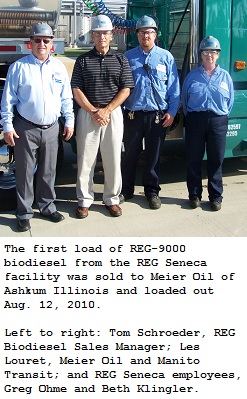On the heels of their great story yesterday on the investment in algal-biodiesel players PetroAlgae and Solazyme (not to mention Joanna’s piece on Gevo preparing for a $150 million IPO), our friends over at Biofuels Digest have put together a list of the top 10 most likely next IPOs in the biofuels sector. The list includes many Domestic Fuel regulars, such as Solazyme, REG and Imperium:
The biofuels companies coming forward are early-to-middle stage: their shared goal is expansion capital, and though they are seen by many as a value-add play for agriculture, or as a technology play, these are best understood as above-ground oil fields, and as a proxy for oil exploration. The difference: the risk for these ventures is less in the geology than in the biology. It is not a question of finding and extracting reserves, as much as growing and extracting them.
1. Solazyme. Already secured investment from Keating Capital, which expressly invests in companies within 18 months of an IPO event. Gaining revenues from military contracts. Has a raft of strategic partners that will prove attractive.
2. LS9. If Amyris goes well, LS9 might well follow at a suitable interval. Their demonstration facility in Florida is easily expandable to 11 Mgy, which would supply them with a revenue stream. Also has attractive strategic partners in the likes of Procter & Gamble. Has a magic bug that, like Amyris’, converts sugar to diesel – though based on e.coli rather than yeast and may have a wider range of near-term molecules – and thereby a story in chemicals – that it can produce.
3. Sapphire Energy.If Solazyme goes, and goes well, Sapphire could follow. They have a big capital raise for their vertically integrated company that intends to be an owner-operator of more than 1 billion gallons in capacity by 2025. The company has scant revenue, and is building out its demonstration plant, but when its operations in New Mexicom are complete, there may be reasons to turn to the public markets for more dollars.
4. REG. The Renewable Energy Group wanted to IPO a few years back, but withdrew. Since then, its been consolidating biodiesel assets at “popular prices”, and has a distribution arm. If biodiesel gets its story back with the US mandate taking hold, REG will likely need fresh equity to balance off any increasing debt and fund its expansion. Not for the near-term, but keep an eye out.Read More




 The new members are: David Kolsrud of Mid-Missouri Energy in Malta Bend, Mo.; Dave Sovereign representing Golden Grain Energy in Mason City, Iowa; and John Skelley, General Manager of Pinal Energy in Maricopa, Arizona.
The new members are: David Kolsrud of Mid-Missouri Energy in Malta Bend, Mo.; Dave Sovereign representing Golden Grain Energy in Mason City, Iowa; and John Skelley, General Manager of Pinal Energy in Maricopa, Arizona. According to a
According to a 




